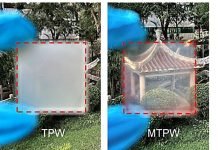
In Singapore, scientists have made a big leap forward by creating ultra-thin threads that could turn regular clothes into smart electronics. Imagine wearing a jacket that could tell you directions or a hat that helps someone who can’t see avoid obstacles.
This isn’t a scene from a sci-fi movie; it’s real, thanks to the team at Nanyang Technological University (NTU).
The challenge with making these threads has always been to keep them flexible and strong enough to work without breaking. Before, when people tried to make these, they often ended up with damaged threads that couldn’t carry signals properly.
The NTU team, however, figured out how to avoid these issues. They did lots of computer tests to understand what was going wrong and then carefully chose the right materials and steps to make strong, flexible threads.
They were so successful that they made fibers thin like hair and very long (100 meters), proving these could be made in large amounts. And they showed you could weave these threads into fabric just like making regular clothes.
To show off how well these threads work, they made some cool prototypes: a hat that can help someone with vision problems safely cross the street by sending messages to a phone, a shirt that acts like a personal tour guide in a museum by whispering info about the art into an earpiece, and a smartwatch band that checks your heart rate better because it fits snugly and moves with you.
These threads are not just a minor upgrade; they’re a big deal because they can be made long and strong without breaking the bank, and they work really well electrically and with light.
Making these amazing threads wasn’t simple. The NTU team chose special pairs of materials that work well together, like a duo where one can handle high heat and another that’s great for sending electrical signals quickly.
They used a clever method where they heated up a tube with the semiconductor material inside until it was soft enough to stretch into a thin thread. It’s a bit like making pasta: you start with a lump of dough (the semiconductor and glass) and stretch it out until you have a long, thin noodle.
This careful cooking and stretching meant they could make threads that are super sensitive to light and can send signals really fast, without getting damaged even if you washed them in a washing machine.
One of the scientists, Dr. Wang Zhixun, said figuring out the perfect mix of materials and methods took a lot of trial and error. But in the end, they managed to make threads that can go through the whole process without getting a single scratch.
These new threads could change how we make and use electronic gadgets. Instead of bulky devices, we could wear sleek watches or clothes with built-in tech. The team is already thinking about what’s next, like using different materials to make threads for more uses.
What’s really cool is how these threads can be made using the same machines that make regular clothes, which means this smart fabric could soon be something everyone can wear.
The scientists have shown that their invention isn’t just for the lab; it’s practical for real-life use, from helping people navigate busy streets safely to making fashion more functional.
They’re now working on exploring more possibilities, like different shapes and types of threads, to see where this technology can go next.
The research findings can be found in Nature.
Copyright © 2024 Knowridge Science Report. All rights reserved.




